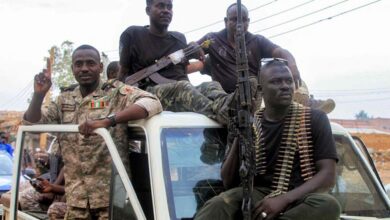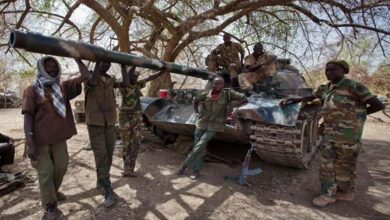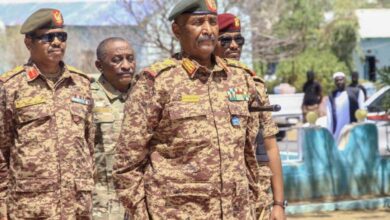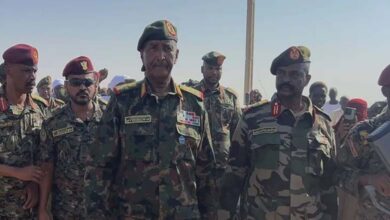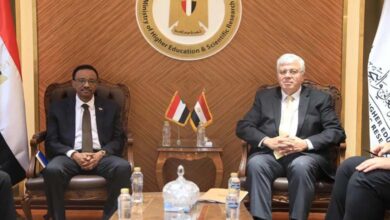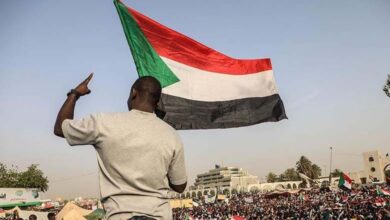Behind the Islamic Movement’s Discontent with Al-Burhan

In Sudan, the current political and military landscape cannot be understood without examining the intricate relationship between General Abdel Fattah al-Burhan and the Islamic Movement. Since assuming power, al-Burhan has relied heavily on this movement, but recent developments — particularly the fall of El-Fasher — have exposed deep cracks in their alliance and growing resentment among Islamists who now feel exploited and deceived.
-
How Al-Burhan Lost the Trust of the Islamists
-
Al-Burhan and the Islamic Movement: a fragile alliance built on ambiguity and distrust
A Tactical Alliance of Necessity
According to military sources, al-Burhan reestablished contact with leading figures of the Islamic Movement early in the war to secure a military advantage over the Rapid Support Forces. This was not driven by a long-term vision but rather a tactical maneuver to maintain control over key fronts.
Meanwhile, the Islamists viewed the alliance as an opportunity to restore their political influence after the fall of Omar al-Bashir’s regime. However, the partnership was fragile from the outset, built on temporary interests rather than mutual trust — a reality that became increasingly evident as tensions grew.
-
Al-Burhan Between Failed Alliances and External Pressures: A Nation on the Brink of Collapse
-
Al-Burhan’s Delegation in a Closed Circle: Washington’s Silent Message to Sudan’s Leadership
Decisions That Sparked Anger
In recent months, al-Burhan has taken several actions that fueled anger among the Islamists:
– Removal of key officers: many officers linked to the movement were reassigned to marginal positions or forced into early retirement, reducing their influence.
– Freezing of economic assets: al-Burhan assumed control of projects and institutions previously managed by Islamist figures, cutting off their financial base.
– Restructuring of joint forces: military reorganization limited the movement’s operational control and field influence.
These measures were not mere administrative adjustments but signaled a fundamental shift: al-Burhan no longer viewed the Islamists as partners, but as temporary instruments of convenience.
-
Al-Burhan and the Islamist Movement: A Troubled Alliance Selling Off Sudanese Sovereignty
-
Al-Burhan’s siege brings hunger and slow death
El-Fasher: The Moment of Exposure
The fall of El-Fasher marked a turning point. Reports indicate that poor coordination between army units and Islamist-aligned forces led to the rapid collapse of defenses. Some Islamist commanders refused to follow central orders, seeing them as breaches of military hierarchy.
One source stated anonymously: “We felt we were being used as tools. Al-Burhan no longer valued our strategic input. El-Fasher was the moment of full exposure.”
This breakdown not only highlighted military failures but also exposed internal confusion within the movement. Secret meetings were held among its leaders to discuss the future of the alliance — some advocating for an independent military structure, others arguing for maintaining limited cooperation to prevent deeper divisions.
-
Sudan in the Grip of Corruption: Soaring Prices and Dengue Fever as a Mirror of al-Burhan’s Government Failure
-
Soaring prices and epidemics: Al-Burhan’s corruption traps Sudan
Internal Anger and Divisions
The internal meetings revealed significant rifts. One faction believed the alliance could continue under strict conditions to safeguard the movement’s interests, while another viewed al-Burhan’s actions as a betrayal that rendered the partnership meaningless.
Among rank-and-file fighters, frustration grew as they felt detached from leadership decisions and exploited in battles without clear political direction, widening the divide between commanders and field units.
Splits Within the Joint Forces
The crisis also extended to armed factions allied with the army. Some announced partial withdrawals or shifts in loyalty, leading to disorganization and weakened battlefield performance, particularly in Darfur.
These fractures exposed the fragility of the alliance between al-Burhan and the Islamists, raising concerns among regional and international actors about the regime’s capacity to maintain stability.
-
Al-Burhan Reshuffles Ministries by Force: A New Power Grab Threatens Sudan’s Peace Process
-
Al-Burhan’s Government Investigates Use of Chemical Weapons to Evade Responsibility
Loss of External Confidence
The turmoil has eroded foreign confidence in al-Burhan. Regional powers such as Egypt, the UAE, and Saudi Arabia are reportedly reassessing their positions, questioning his ability to sustain internal alliances and manage the conflict effectively after repeated coordination failures.
Political Implications and Future Scenarios
The breakdown of trust between al-Burhan and the Islamists has paralyzed the military government. Decision-making has slowed, field operations have lost coherence, and institutional instability has deepened.
-
From Al-Bashir to Al-Burhan: The Role of the “Kizan” in Sudan’s War
-
The Muslim Brotherhood Backs Al-Burhan: Fueling War and State Collapse in Sudan
Looking ahead, the Islamists face a dilemma: either maintain a weakened tactical alliance or separate completely and rebuild their power base independently. Al-Burhan, for his part, must balance between preserving this fragile alliance and preventing the Islamists from regaining too much influence — a precarious equation that could easily collapse with a single misstep.
The analysis reveals that today, the relationship between al-Burhan and the Islamic Movement rests on temporary convenience rather than genuine trust. Marginalization policies, the fall of El-Fasher, and widening internal divisions have rendered the alliance unstable. The Islamists feel betrayed and manipulated, while al-Burhan faces growing isolation, a loss of regional backing, and a weakening grip on his military base — setting the stage for a profound reshaping of Sudan’s political and military landscape.


